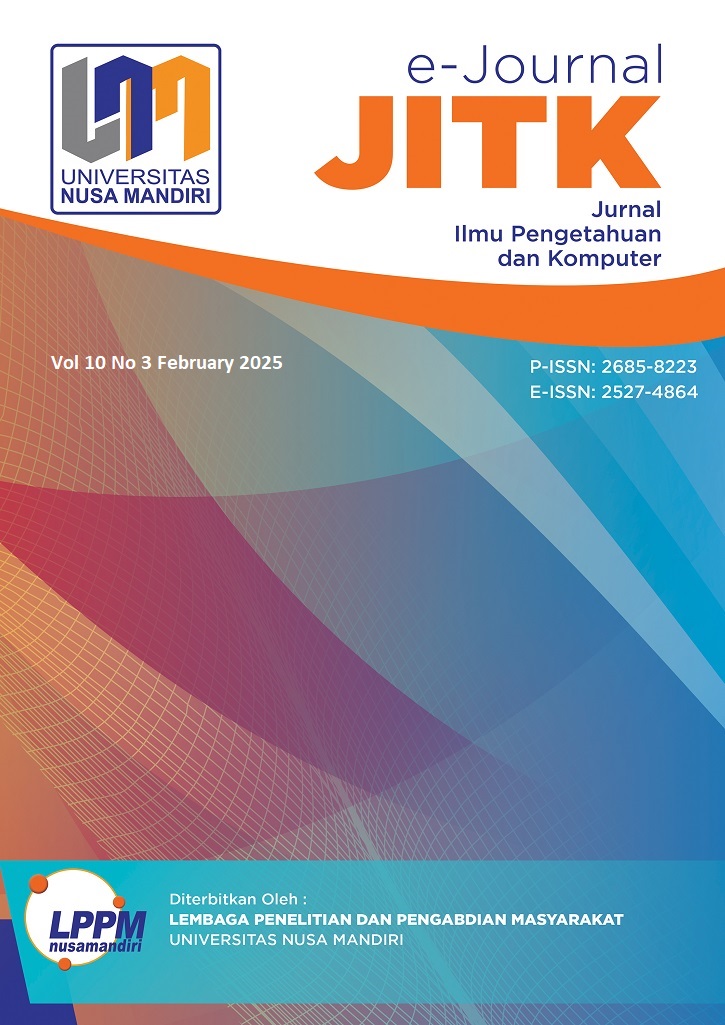SMART ATTENDANCE TRACKING SYSTEM EMPLOYING DEEP LEARNING FOR FACE ANTI-SPOOFING PROTECTION
DOI:
https://doi.org/10.33480/jitk.v10i3.5992Keywords:
anti-spoofing, deep learning, OpenCV, smart attendance, system performanceAbstract
Conventional attendance systems face challenges in accuracy and efficiency, often vulnerable to spoofing and data manipulation. This study addresses these issues by developing a smart attendance system integrating Deep Learning-based facial recognition with anti-spoofing technology. The system ensures secure and reliable attendance authentication while automating and enhancing management processes. Utilizing a convolutional neural network (CNN) architecture, the system processes raw facial images directly without additional feature extraction, improving accuracy and efficiency. A novel training strategy, termed 50 Random Samples-30 Sub-epochs Count-1 Epoch, is introduced to optimize the training process. This strategy involves random sampling during each forward pass and grouping 30 passes as one epoch, enabling the use of complex CNN architectures and automatic dataset expansion. The system achieves 98.90% accuracy in identifying genuine attendance, maintaining a confidence level above 80%, significantly reducing spoofing risks and errors. This innovative solution has significant implications, particularly for educational institutions. It automates attendance tracking, minimizes manual effort, reduces errors, and supports disciplinary enforcement through accurate data. Moreover, its scalability allows for application across various environments, offering benefits to a wide range of institutions. By enhancing data accuracy and operational efficiency, this system sets a foundation for smarter, more reliable attendance management, strengthening administrative practices in education and beyond.
Downloads
References
Z. Zulkifli and A. I. Pawelloi, “Implementasi Opencv Face Recognition Pada Sistem Presensi Karyawan Koperasi Simpan Pinjam,” J. Sintaks Log., vol. 3, no. 1, pp. 58–61, 2023, doi: 10.31850/jsilog.v3i1.2095.
T. V. Dang, “Smart Attendance System based on Improved Facial Recognition,” J. Robot. Control, vol. 4, no. 1, 2023, doi: 10.18196/jrc.v4i1.16808.
M. W. Septyanto, H. Sofyan, H. Jayadianti, O. S. Simanjuntak, and D. B. Prasetyo, “Aplikasi Presensi Pengenalan Wajah Dengan Menggunakan Algoritma Haar Cascade Classifier,” Telematika, vol. 16, no. 2, p. 87, 2020, doi: 10.31315/telematika.v16i2.3182.
Z. Wang, “Higher Education Management and Student Achievement Assessment Method Based on Clustering Algorithm,” Comput. Intell. Neurosci., vol. 2022, 2022, doi: 10.1155/2022/4703975.
R. Bairagi, R. Ahmed, S. A. Tisha, M. S. Sarder, M. S. Islam, and M. A. Islam, “A Real-time Face Recognition Smart Attendance System with Haar Cascade Classifiers,” Proc. 3rd Int. Conf. Inven. Res. Comput. Appl. ICIRCA 2021, no. October, pp. 1417–1425, 2021, doi: 10.1109/ICIRCA51532.2021.9544872.
C. Fadli and D. Desmulyati, “Implementasi Perhitungan Face Detection Dengan Metode Haar Cascade Classifier,” J. Nas. Komputasi dan Teknol. Inf., vol. 4, no. 6, pp. 535–542, 2021, doi: 10.32672/jnkti.v4i6.3721.
K. Marzuki, N. Hanif, and I. P. Hariyadi, “Application of Domain Keys Identified Mail, Sender Policy Framework, Anti-Spam, and Anti-Virus: The Analysis on Mail Servers,” International …. download.garuda.kemdikbud.go.id, 2022.
A. P. Nanda, D. E. H. Pramono, and S. Hartati, “Menentukan Tingkat Kepuasan Mahasiswa Terhadap Pelayanan Akademik Menggunakan Metode Algoritma K-Means,” J. Sist. Inf. dan Telemat., vol. 11, no. 1, pp. 23–28, 2020.
Y. Hartiwi, E. Rasywir, Y. Pratama, and P. A. Jusia, “Eksperimen Pengenalan Wajah dengan fitur Indoor Positioning System menggunakan Algoritma CNN,” Paradig. - J. Komput. dan Inform., vol. 22, no. 2, pp. 109–116, 2020, doi: 10.31294/p.v22i2.8906.
I. K. S. Buana, “Penerapan Pengenalan Wajah Untuk Aplikasi Absensi dengan Metode Viola Jones dan Algoritam LBPH,” J. MEDIA Inform. BUDIDARMA, vol. 5, no. 3, 2021, doi: 10.30865/mib.v5i3.3008.
M.A Thalor and Omkar S. Gaikwad, “Facial Recognition Attendance Monitoring System using Deep Learning Techniques,” Int. J. Integr. Sci. Technol., vol. 2, no. 1, 2024, doi: 10.59890/ijist.v2i1.1290.
J. Ilmiah and R. Darmawan, “Perancangan Sistem Absensi menggunakan Face Recognition dengan Haar Cascade Classifier,” vol. 5, no. 2, pp. 1–8, 2023.
T. Susim and C. Darujati, “Pengolahan Citra untuk Pengenalan Wajah (Face Recognition) Menggunakan OpenCV,” J. Syntax Admiration, vol. 2, no. 3, pp. 534–545, 2021, doi: 10.46799/jsa.v2i3.202.
F. Fahraini and R. Syarif, “Pengaruh Kompensasi, Disiplin Kerja dan Komunikasi Terhadap Kinerja Karyawan PT. Nikos Distribution Indonesia,” Ikraith-Ekonomika, vol. 5, no. 1, pp. 20–30, 2022.
D. N. P. Sari, ANALISIS CLUSTER DENGAN METODE K-MEANS PADA PERSEBARAN KASUS COVID-19 BERDASARKAN PROVINSI DI INDONESIA. 2020.
D. A. Kurnia, A. Setiawan, D. R. Amalia, R. W. Arifin, and D. Setiyadi, “Image Processing Identifacation for Indonesian Cake Cuisine using CNN Classification Technique,” J. Phys. Conf. Ser., vol. 1783, no. 1, 2021, doi: 10.1088/1742-6596/1783/1/012047.
A. Info and D. I. Signature, “Application of 2DPCA and SOM Algorithms to Identification of Digital Signature Ownership,” vol. 16, no. 3, pp. 208–218, 2023, doi: 10.30998/faktorexacta.v16i3.17504.
E. Muningsih, I. Maryani, and V. R. Handayani, “Penerapan Metode K-Means dan Optimasi Jumlah Cluster dengan Index Davies Bouldin untuk Clustering Propinsi Berdasarkan Potensi Desa,” J. Sains dan Manaj., vol. 9, no. 1, p. 96, 2021, [Online]. Available: www.bps.go.id
Q. Aini, W. Febriani, C. Lukita, S. Kosasi, and ..., “New normal regulation with face recognition technology using attendx for student attendance algorithm,” … Sci. …, 2022.
R. Liu, “Data Analysis of Educational Evaluation Using K-Means Clustering Method,” Comput. Intell. Neurosci., vol. 2022, 2022, doi: 10.1155/2022/3762431.
Z. Trabelsi, F. Alnajjar, M. M. A. Parambil, M. Gochoo, and L. Ali, “Real-Time Attention Monitoring System for Classroom: A Deep Learning Approach for Student’s Behavior Recognition,” Big Data Cogn. Comput., vol. 7, no. 1, pp. 1–17, 2023, doi: 10.3390/bdcc7010048.
U. Muhammad, M. Z. Hoque, M. Oussalah, and J. Laaksonen, “Deep Ensemble Learning with Frame Skipping for Face Anti-Spoofing,” 2023. doi: 10.1109/IPTA59101.2023.10320013.
Q. Aini, W. Febriani, C. Lukita, S. Kosasi, and U. Rahardja, “New Normal Regulation with Face Recognition Technology Using AttendX for Student Attendance Algorithm,” 2022. doi: 10.1109/ICOSTECH54296.2022.9829079.
R. P. K. Banu Santoso, “IMPLEMENTASI PENGGUNAAN OPENCV PADA FACE RECOGNITION UNTUK SISTEM PRESENSI PERKULIAHAN MAHASISWA,” Andrew’s Dis. Ski. Clin. Dermatology., vol. 9, pp. 352–361, 20AD.
Downloads
Published
How to Cite
Issue
Section
License
Copyright (c) 2025 Bani Nurhakim, Ahmad Rifai, Dian Ade Kurnia, Dadang Sudrajat, Ujang Supriatna

This work is licensed under a Creative Commons Attribution-NonCommercial 4.0 International License.











-a.jpg)
-b.jpg)














